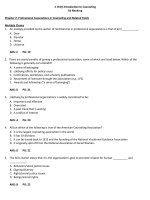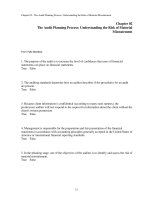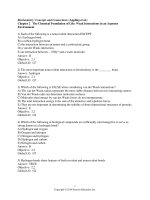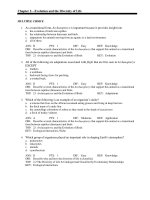Homeland security the essentials 1st edition bullock test bank
Bạn đang xem bản rút gọn của tài liệu. Xem và tải ngay bản đầy đủ của tài liệu tại đây (276.07 KB, 9 trang )
Chapter 2
Historic Overview of the Terrorist Threat
The actions of the US Government in the wake of 9/11 to reorganize emergency management
and public safety and security may have seemed unprecedented, but such is not the case. The
reality is that similar actions in terms of both type and scope have happened in the past, and these
historical experiences can provide insight into the prospect of the ultimate success or failure of
the actions that have been taken since the September 11 attacks occurred. Previous
reorganizations and historical emergency management experience offer insight into Homeland
Security’s future.
Early History: From 1800’s to the Creation of FEMA
The U.S. government has a long history of responding to all types of threats and emergencies
before terrorism became an emerging threat in the 1990s. The first federal involvement in
disaster management began with an 1803 Congressional act to provide financial assistance to a
New Hampshire town. During the 1930s, the Reconstruction Finance Corporation and the
Bureau of Public Roads made disaster loans available for public facilities. The next notable
period of evolution occurred during the 1950s. The Cold War era presented the potential for
nuclear war and nuclear fallout as the principal disaster risk. Civil defense programs proliferated
across communities during this time.
Federal support for these activities was vested in the Federal Civil Defense Administration
(FCDA), an organization with few staff and limited financial resources whose main role was to
provide technical assistance. A companion office to the FCDA, the Office of Defense
Mobilization, was established in the Department of Defense (DOD). The primary functions of
this office were to allow for the quick mobilization of materials and the production and
stockpiling of critical materials in the event of war. In 1958, these two offices were merged into
the Office of Civil and Defense Mobilization.
The 1960s were marked by a number of major natural disasters, one of which the Hebgen
Lake Earthquake) raised attention to the fact earthquake risk extended far beyond California’s
borders. Following Hurricanes Donna and Carla, the incoming Kennedy administration decided
to change the federal approach to disasters and created the Office of Emergency Preparedness
inside the White House, distinguishing these activities from the civil defense responsibilities.
The remainder of the 1960s continued to see devastating natural disasters, the most damaging of
which were the 1964 Prince William Sound Earthquake, Hurricane Betsy, and Hurricane
Camille. Government responded with the passage of ad hoc legislation for funds.
The disaster relief act of 1974 gave HUD the greatest EM authority, though EM functions
existed concurrently in several other federal agencies. Under President Carter, with strong state
support and following the accident at Three Mile Island, the Federal Emergency Management
Agency was created in 1978. Under FEMA, the majority of federal EM tasks were consolidated.
However, FEMA’s first years were marked by a resistance to such integration. During the
1980’s, FEMA’s top priority was nuclear attack preparedness. Statutory authority steadily
moved from the State to the Federal level, and funding for State and local programs decreased.
When Hurricane Andrew struck in 1992, response across the entire Federal government was
poor. Investigations by the General Accounting Office (GAO) and other governmental and
nongovernmental watchdog groups called for major reforms. The threat of a major natural
disaster or even multiple disasters was the Government’s primary concern at that time, with other
man-made and intentional risks considered remote. Knowledge of terrorist risk existed by the
assumption was that it would occur overseas. This changed with the 1993 World Trade Center
bombing.
World Trade Center Bombing
The bombing of the World Trade Center presented a new threat of large-scale terrorism.
Prior to this event, bombings typically targeted local government offices such as Post Offices
and medical facilities. Also these events were considered criminal acts by individuals rather than
a concerted international effort. This bombing resulted in increased counter terrorism efforts,
including the Violent Crime Control and Law Enforcement Act of 1994. This Act was the most
comprehensive crime legislation in U.S. history..
Murrah Federal Building Bombing
At 9:02 am on the morning of April 19, 1995, a bomb exploded from inside a Ryder truck
under the Alfred P. Murrah Federal Building in Oklahoma City. The blast caused a partial
collapse of all nine floors of the 20-year-old building, and 168 people died. This event boosted
efforts to establish the Nunn-Lugar Domenici legislation that was aimed at better preparing the
nation for a terrorist attack and to provide the primary authority and focus for domestic federal
terrorism preparedness activities. This legislation, the Defense against Weapons of Mass
Destruction Act of 1996, did not, however, address who would be the lead agency in terrorism.
Khobar Towers Bombing, Saudi Arabia
On June 25, 1996 a truck bomb was detonated at the U. S. forces command in the Khobar
Towers building in Riyadh. The quick actions of an Air Force sentry minimized the deaths and
injuries, and anonymous communications prior to the attack gave indication that something
might be imminent. In the aftermath of the attack, most felt this was the result of intelligence
failure.
The Three Commissions
Three commissions were formed in the aftermath of the Khobar Towers incident to
investigate and act on the rising threat of terrorism. These include:
The United States Commission on National Security/21st Century (USCNS/21 - also
known as the Hart-Rudman Commission). This commission was created to make
strategic recommendations on how the U.S. government could ensure the nation’s
security in the coming years. This commission recommended the creation of a National
Homeland Security Agency (NHSA) with responsibility for planning, coordinating, and
integrating various U.S. government activities involved in homeland security. Many of
this commission’s findings were later integrated into the justification and legislation
behind the creation of the Department of Homeland Security (DHS).
The Gilmore Commission (also known as the Advisory Panel to Assess Domestic
Response Capabilities for Terrorism Involving Weapons of Mass Destruction).
The Bremer Commission (also known as the National Commission on Terrorism).
Presidential Decision Directives 62 and 63
President Clinton addressed recognized and immediate needs through the passage of several
presidential decision directives (PDDs) as terrorist attacks continued to occur against the US and
US interests worldwide. These include:
PDD-62, entitled “Combating Terrorism”
PDD-63, entitled “Protecting America’s Critical Infrastructure”
Attorney General’s Five-Year Interagency Counterterrorism and Technology Crime Plan
In December 1998, as mandated by Congress, the Department of Justice (DOJ), through the
Federal Bureau of Investigation (FBI), began a coordinated project with other agencies to
develop the Attorney General’s Five-Year Interagency Counterterrorism and Technology Crime
Plan. The FBI emerged as the federal government’s principal agency for responding to and
investigating terrorism. Congress had intended the plan to serve as a baseline for the
coordination of a national strategy and operational capabilities to combat terrorism.
USS Cole Bombing, Yemen
On October 12, 2000, while refueling in the port of Aden in Yemen, the U.S. Navy destroyer,
the USS Cole sustained a suicide bomb attack. Differences existed about whether this was an act
of terrorism or war. Both the Clinton and Bush Administrations have been criticized for not
responding with military force on this attack before the September 11 attack.
The September 11, 2001 Terrorist Attacks
The September 11, 2001 terrorist attacks, which involved the hijacking and intentional crashing
of four commercial airplanes hijacked and used as weapons, were together a watershed event in
the creation of a homeland security department. This event resulted in the collapse of several
buildings in downtown New York City (including both World Trade Center towers), the collapse
of a section of the Pentagon, and a crash into a field in Pennsylvania. The loss of 2,974 lives, of
which 343 were firefighters and 75 police officers, shocked both the public and the government,
and immediately changed the way of life in America.
The Creation of The Department of Homeland Security: 2001 – 2004;
Just nine days after the 9/11 attacks, President George W. Bush announced by executive
order that an Office of Homeland Security would be established within the White House directed
by PA Governor Tom Ridge. This order also created the Homeland Security Council, “to
develop and coordinate the implementation of a comprehensive national strategy to secure the
United States from terrorist threats or attacks.” Four days later, President Bush announced he
would be seeking passage of the PATRIOT Act of 2001 which has created considerable
controversy in the weeks and years that have followed since. On October 29, 2001, President
Bush issued the first of many homeland security presidential directives (HSPDs). On March 21,
2002, President Bush signed Executive Order 13260 establishing the President’s Homeland
Security Advisory Council (PHSAC) and Senior Advisory Committees for Homeland Security.
And also in March of 2002, the President issued HSPD-3, which created the color-coded
Homeland Security Advisory System
The 9/11 Commission
As a result of the 9/11 attacks, President Bush established the National Commission on
Terrorist Attacks Upon the United States, informally known as the 9/11 Commission. The
Commission was charged with looking at the events leading up to the September 11 attacks and
the actions that were taken immediately following the attack and make recommendations to the
President and the Congress. The major findings of the Commission report, issued on July 22,
2004, were that there were government failures in policy, capabilities and management.
Homeland Security Focus Results in a Disaster: Hurricane Katrina and its Aftermath
Of the criticisms vaulted at DHS, one of the most significant was that the emergency
management focus at all government levels had shifted from the all-hazards philosophy towards
a linear focus on terrorism. A failed response to Hurricane Katrina exposed cracks in the nation’s
emergency management system, judged by both government and independent after action
reports. Many of the problems were found to be the result of a priority focus on terrorism. While
elected officials and response agencies stumbled, NGOs stepped up to provide the extraordinary
services to storm victims. Congress drew up legislation (the Post Katrina Emergency
Management Reform Act) to patch many of the holes that had been exposed, and developed new
systems to reduce future failure. For the moment, at least, it seemed as if the nation’s emergency
management focus was willing to regain its all-hazards approach.
Obama Administration
Many expected dramatic change relative to Homeland Security when President Obama was
elected. Some even expected the new Administration would remove FEMA from DHS.
However, this did not happen. Recognizing the importance of border issues, President Obama
nominated Janet Napolitano to be DHS Secretary, and she was (and remains) committed to
addressing issues facing the Department as well as aggressively tackling the emerging threats
such as cyber security. Despite this, on Christmas Day, 2009, a Nigerian national attempted
unsuccessfully to detonate explosives hidden in his underwear, prompting Napolitano to admit
that the system had failed (after initially touting success). On the contrary, a high point in the
Administration’s efforts came when bin Laden was located and killed on May 2, 2011. In May
2011, the Obama Administration proposed comprehensive cybersecurity legislation. Among the
highlight in this legislation include consolidating the 47 different State laws that require
businesses to report breaches of their cyber systems to consumers, DHS will work with industry
to prioritize most important cyber threats and vulnerabilities, provide clear authority to allow the
federal government to provide assistance to State and local governments when there has been a
cyber-breach, provides immunity to the industry, states and local government when sharing
cybersecurity information with DHS, and provides for a new framework to protect individual’s
privacy and civil liberties.
Multiple Choice Questions
1. The first large-scale terrorist attack on American soil was which of the following?
a. The September 11th Attacks
b. The bombing of the USS Cole
c. The bombing of the World Trade Center*
d. The bombing of the Murrah building in Oklahoma City
2. How many people were evacuated from the World Trade Center after a truck bomb was
detonated it its underground parking garage?
a. 5,000
b. 15,000
c. 50,000*
d. 500,000
3. The first time the federal government became involved in a local disaster following which of
the following?
a. A town in New Hampshire was destroyed by a fire in 1803*
b. St. Louis, Missouri is flooded in 1815
c. A series of tornadoes devastates several communities in Oklahoma in the 1830s
d. Hurricane Oswald causes severe damage in five Atlantic states in 1877
4. During the 1930s, the Reconstruction Finance Corporation and the Bureau of Public Roads
were both given authority to do which of the following?
a. Prevent construction that increased slope failures, thereby reducing landslide risks
b. Buyback properties in the floodplain and create ‘green spaces’
c. Perform annual ‘controlled burns’ to reduce wildfire risk
d. Make disaster loans available for repair and reconstruction of certain public facilities
after disasters*
5. The Civil Defense programs in the 1950s were established primarily to protect American
communities from which of the following hazards?
a. Rioting and other civil disobedience
b. Technological disasters brought about by increased industrial production
c. Nuclear fallout brought on by a Soviet nuclear attack*
d. Invasion into American soil of a foreign military’s troops
6. The primary functions of the Office of Defense Mobilization, which merged with the Federal
Civil Defense Administration in 1958, were which of the following?
a. Production, stockpiling, and quick mobilization of critical materials in the event of war*
b. Mobilization of disaster relief supplies in response to major natural disasters
c. Transportation of military troops to disaster sites for response assistance
d. All of the above
7. The Hebgen Lake Earthquake, which measured 7.3 on the Richter scale, brought attention to
which of the following:
a. Earthquake retrofitting in older structures was desperately needed
b. The nation’s earthquake risk went beyond the California borders*
c. The federal response to natural disasters would require the use of the military
d. Secondary disasters sparked by an initial disaster can have severe consequences
8. Which of the following is a new position created at FEMA HQ as a result of PKEMRA?
a. Disability Coordinator
b. Small State and Rural Advocate
c. Law Enforcement Advisor
d. All of the above*
9. With the passage of the Disaster Relief Act of 1974, which federal agency possessed the most
significant authority for natural disaster response and recovery
a. DOD
b. HUD*
c. FEMA
d. DHS
10. Prior to September 11th, which of the following pieces of legislation provided the primary
authority and focus for domestic Federal preparedness activities for terrorism?
a. Civil Defense Act of 1950
b. Defense Against Weapons of Mass Destruction Act of 1996*
c. Terrorism Reduction Act of 1980
d. None of the above
11. President Carter sought to consolidate emergency preparedness, mitigation, and response
activities into one government agency at the federal level. This plan, called Reorganization Plan
Number 3, resulted in the creation of which of the following?
a. Defense Civil Preparedness Agency
b. Federal Emergency Management Agency*
c. Federal Disaster Assistance Administration
d. Federal Preparedness Agency
13. In response to the bombing of the World Trade Center in 1993, Congress passed and
President Clinton signed which of the following?
a. Violent Crime Control and Law Enforcement Act of 1994*
b. Counter-Terrorism Prevention Act (CTPA) of 1994
c. Homeland Defense and Protection Act of 1993
d. All of the above
14. Operation “Neptune Spear” was carried out for what purpose?
a. To kill or capture al Qaeda leader Osama bin Laden*
b. To prevent maritime terrorist attacks
c. To ensure that terrorism was given the primary emergency management focus
d. None of the above
15. The September 11th Terrorist attacks were the primary impetus for the creation of which of
the following agencies?
a. The Office of Domestic Preparedness
b. The Office of National Preparedness
c. The Department of Homeland Security*
d. The National Security Agency
16. HSPD-3 did which of the following?
a.
b.
c.
d.
Created the Office of Homeland Security
Created the Homeland Security Advisory System*
Abolished the civil defense directors
Created a fund to support first responder terrorism preparedness
17. The failed response to Hurricane Katrina resulted in which of the following?
a. Greater Federal funding for first responders aimed at natural hazard management
b. Removal of FEMA from the Department of Homeland Security
c. A transfer of disaster command authority from the local level to the state level
d. Passage of the Post-Katrina Emergency Management Reform Act*
18. Which of the following commissions was most clearly focused on the international terrorist
threat?
a. The Hart-Rudman Commission
b. The Gilmore Commission
c. The Bremer Commission*
d. The 9/11 Commission
19. Which of the following events first raised the issue of America’s preparedness for terrorism
events?
a. The bombing of the World Trade Center
b. The Oklahoma City bombing*
c. Ruby Ridge
d. The September 11th Terrorist Attacks in New York, Washington, D.C., and Pennsylvania
20. What President issued PDD 62 and 63 to combat terrorism and protect infrastructure?
a. President George H.W. Bush
b. President William Clinton*
c. President George W. Bush
d. President Barack Obama
True or False Questions
1. Terrorism has long been the focus of emergency management in the United States, even
before the creation of FEMA.
a. True b. False*
2. The Khobar Towers incident was considered to be an intelligence failure.
a. True* b. False
3. A Department of Homeland Security at the Federal Government level was conceived prior to
September 11th.
a. True* b. False
4. The US Government was criticized for being too aggressive in their military response to the
attack on the USS Cole.
a. True b. False*
5. The Civil Defense directors of the 1950s ran local programs that were well funded by the
federal government.
a. True b. False*
6. Local and state civil defense directors were the first recognized face of emergency
management in the United States.
a. True* b. False
7. The Cold War era presented the potential for nuclear war and nuclear fallout as the principal
disaster risk.
a. True* b. False
8. The concept of homeland security is still considered a work in progress.
a. True* b. False
9. Cybersecurity is a problem faced by individuals given that large corporations have virtually
insulated themselves from possible attack.
a. True b. False*
10. The Obama administration has adopted several Bush era homeland security practices.
a. True* b. False
11.The insurance losses associated with the September 11th attacks were among the highest
reached in a domestic disaster, despite that very little physical property was actually destroyed in
relation to other natural disasters.
a. True* b. False
12. One of the principal foci of the PATRIOT Act is to provide law enforcement agencies with
the proper legal authority to support their efforts to collect information on suspected terrorists.
a. True* b. False
13. The Gilmore Commission developed a series of reports that expanded current knowledge
about the ongoing threat from the al Qaeda network.
a. True b. False*
14. The GAO found that the Attorney General’s Five Year Interagency Counterterrorism and
Technology Crime Plan represented a comprehensive national strategy to address the terrorist
threat.
a. True b. False*
15. The 9/11 Commission called on government to attack terrorists and their organizations.
a. True* b. False
16. In late 1992, when Hurricane Andrew and Hurricane Iniki struck within months of each
other, FEMA performed outstandingly well in responding to the disasters.
a. True b. False*
17. President Obama directed the use of an ‘Autopen machine’ to sign a bill extending Patriot
Act provisions to ensure they did not expire while he was out of the country.
a. True* b. False
18. The failed federal government response to Hurricane Katrina was deemed to be primarily the
result of a misguided focus on terrorism hazards by the newly formed Department of Homeland
Security.
a. True* b. False
19. Actions taken in the aftermath of the 1993 World Trade Center bombing were credited with
saving lives in the September 11th terrorist attacks.
a. True* b. False
20. In the mid-1990s, following the introduction of the Nunn-Lugar legislation, FEMA failed to
claim the role as lead agency for terrorism events.
a. True* b. False
Essay Questions
1. Describe the evolution of Homeland Security from 1800 to present day.
2. Describe the role of the “3 Commissions” in light of pre- and post-September 11th knowledge
about terrorist risk.
3. Choose one natural disaster and one terrorism disaster, each of which had a significant impact
on the practice of emergency management, and describe that influence.
4. Explain why some people are unhappy with the provisions of the PATRIOT Act, and provide
your opinion about whether or not you feel this law could have passed prior to the September
11th events.
5. Explain briefly how FEMA failed to garner lead agency status for the terrorism hazard.









